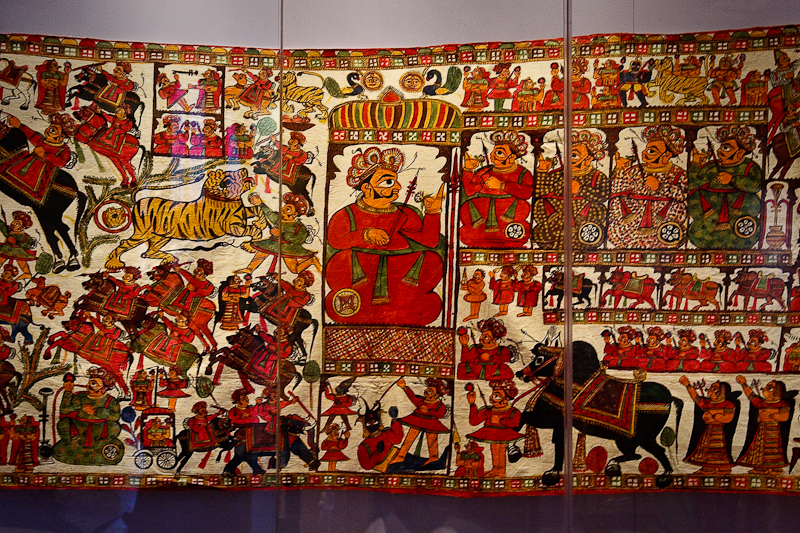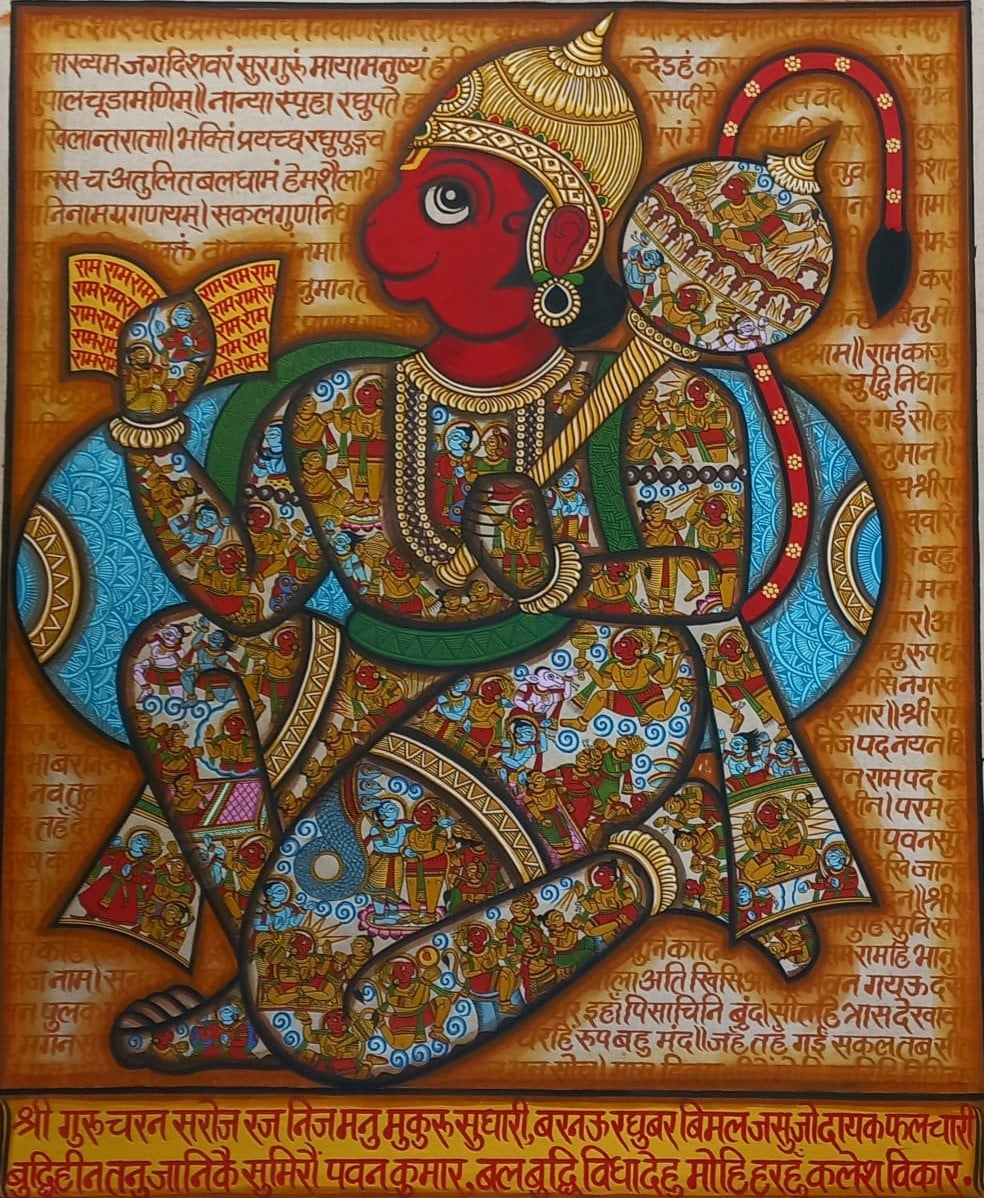Introduction
Rajasthan contains mountains, deserts, plateaus, and plains, which further enhance the land’s diversification. Also existing in its biodiversity is a variety of fauna and flora. The state is known and loved for its rich heritage and culture, as it is famous for the traditional arts that sculpt the amazing beauty of diversity.

One such traditional art that is rich in history and tells captivating stories, which is essentially a painting of scrolls and done orally, is Phad painting.
Phad Painting of Rajasthan
Phad painting is one of the oldest forms of art from Rajasthan that is done on scrolls depicting sacred and folklore Phad painting is one of the oldest forms of art from Rajasthan that is done on scrolls depicting sacred and folklore tales. Both types of painting serve as an aid for visual representation of oral traditions. The word phad means “fold” in one of the local dialects of the region. These scrolls were kept in ancient times and only shown after the sun had set. Nightlong chants and performances were done while narrating the story to the people.
Its Origin

Phad painting is said to have been started by the people of Shahpura in the Bhilwara district of Rajasthan, India, around 700 years ago. Intended for worship on the go, these scrolls were carried around by Bhopas—singing priests who narrated the stories of the local gods depicted in the scrolls. This art was kept in the family of Joshi of the Chipa caste. They were the sole producers of Phad painting. These were known as the mobile temples as they can be moved from place to place.
Joshi artists were explicitly hired to paint for Pabuji and Devnarayanji’s performances. A Pabuji Ki Phad is said to have customarily been 13 arm lengths long, and “Devnarayan Ki Phad would extend vividly to 30 feet long.”
Themes and Narratives of Phad Painting

Phad paintings revolve around the lives of the folk deities, such as Pabuji, Devnarayanji, and Ramdevji, and their miracles and heroic acts. Over a period of time, even characters and scenarios of the Ramayana and Mahabharata, and even Hanuman Chalisa and the Panchatantra, are included in these paintings.
The principal deity is surrounded by lesser deities in orbits to indicate their lower divine or social position. “Phad Kavitas,” which are a mix of Rajasthani verse and couplets, are poetic descriptions of the visual elements. In the performances, a male Bhopa sings and recites, and his female equivalent dances and lights up the scroll with a lamp. The two-stringed Ravanhatta is played to accompany such performances.
Motifs illustrated in Phad painting
- Local gods and goddesses: The mythological stories of the folk deities of Rajasthan, primarily of Pabuji and Devnarayanji, are illustrated on the phad, such as the popular Pabuji ka Vivah, which illustrates the marriage
Ramayana Phad Painting Source: Artisera procession and other ceremonies of Pabuji’s wedding.
- Scenes from epics, such as the Ramayana and Mahabharata, and even the Hanuman Chalisa also began to be shown in the scrolls as time went by.
- Tales from the renowned book Panchatantra.
Techniques and Materials
As it is a far more complex matter, the Phad artists need to be extraordinarily professional, adhering to the techniques taught with the aid of ancestors, and thus can take between a few weeks and a few months to finish a painting.
Phad artworks are essentially created with handwoven coarse cotton fabric that is soaked overnight to thicken

the threads. It is miles then stiffened with starch from rice or wheat flour and then dried in the sun and rubbed with a moonstone to give it a shine.
The entire procedure of making a Phad portrayal is completely natural, using herbal fibers and natural paints sourced from stones, plant life, flowers, and herbs. The paints are homemade by the artists and mixed with gum and water earlier than making use of the fabric.
The most crucial element within the artwork is the eyes that are added last. As soon as the primary deity’s eyes are painted, the artwork comes alive and is ready for worship. The particular aspect of Phad artwork is that the development of the figures is flat, and they all face each other, rather than going through the viewer of the portrayal. The unique aspect of Phad paintings is that the construction of the figures is flat, and they all face each other instead of facing the viewer of the painting.
Change in modern times
As the tradition of the Phad painting is closely guarded, it was but natural to face the threat. Thus, Lalji Joshi, a renowned phad artist, decided to set up Joshi Kala Kung in Bhilwara, Rajasthan, where the artists outside the Joshi family were taught the art of phad. Kalyanji Joshi started depicting characters beside Pabuji, like stories from the Ramayana, Mahabharata, and even Panchatantra.
Conclusion
Through the years, phad painting has developed both in form and subject. Modern artists have made adjustments to the art form to accommodate contemporary sensibilities, adding new themes without diminishing its classic character. Such a development allowed the art to be preserved and introduced to newer generations and international audiences.
Even with these advancements, the existence of Phad painting relies on sustained patronage for traditional artists and appreciation of its cultural significance. Efforts to educate and popularize Phad through workshops, exhibitions, and scholarly research are important. In summary, Phad painting is not only a work of art but a living tradition that embodies the soul of Rajasthani folklore. It should continue to be appreciated and preserved as an invaluable component of India’s intangible cultural heritage.
References:
https://www.artisera.com/blogs/expressions/phad-paintings-of-rajasthan
https://www.traditions-tanjoresetc.com/about
https://www.bridgebharat.com/blogs/posts/tradition-of-phad-art




